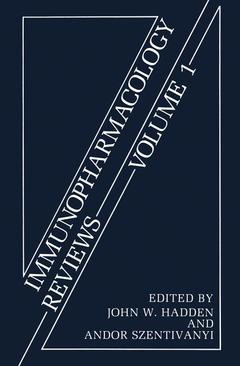Immunopharmacology Reviews, Softcover reprint of the original 1st ed. 1990 Volume 1
Langue : Anglais
Coordonnateurs : Hadden J.W., Szentivanyi A.

Immunopharmacology as a field of scientific endeavor had its origins more than thirty years ago in the application of antibody-based techniques to assays of hormones and drugs in tissues and body fluids. More recently, the field has been redefined to include a primary focus on the immune system as a target of xenobiotic action. Advances in the field of immunology have made it apparent that the immune system, like other organ systems, declines in its function as a result of aging, viral infections like AIDS, and other immunotoxic influences, giving rise to secondary immunodeficiency. Deficiencyof the immune system in turn leads to infections, autoimmune diseases, and an increased incidence of certain cancers. The notion of treating the failing immune system is relatively new; however, more than a decade of research on cancer and AIDS has created the burgeoning new clinical field of immunotherapy. Immunopharmacology then stands as the preclinical and clinical science of immune manipulation. As such, like its parent field of pharmacology, it includes within its scope basic studies of immune mechanisms as they relate to the pathogenesis of inflammation and immunologic disturbances. As with pharma cology, the perspective is always a therapeutic one. Studies of immune and inflammatory processes emphasize the use of pharmacologic probes and drugs to elucidate the underlying biochemical pharmacology.
1 The Characterization of Immunotherapeutic Agents.- 1. Introduction.- 2. Immunotherapeutic Agents.- 2.1. Immune System-Derived Biologicals.- 2.2. Bacteria and Fungi.- 2.3. Drugs.- 3. General Features of the Mode of Action of Immunotherapeutic Biologicals and Drugs.- 3.1. Classification.- 3.2. Pharmacokinetics.- 3.3. Immunopharmacodynamics.- 3.4. Toxicology.- 3.5. Side Effects.- 3.6. Dose and Route of Administration.- 3.7. General Clinical Pharmacology Principles Relating to Drug Development.- 4. Preclinical Characterization of Agents.- 4.1. In Vitro Immunopharmacology.- 4.2. In Vivo Characterization of Immunotherapeutic Agents.- 5. Preclinical Therapeutic Studies in Animal Models.- 5.1. Physiological Immunodeficiencies.- 5.2. Iatrogenic Immunodeficiencies.- 5.3. Autoimmune Disease Models.- 5.4. Infections.- 5.5. Cancer.- References.- 2 Pharmacokinetics of Immunomodulators.- 1. Introduction: Pharmacokinetics.- 1.1. Absorption.- 1.2. Distribution.- 1.3. Elimination.- 2. Pharmacokinetics of Immunomodulators.- 2.1. Biologically Derived Immunomodulators and Related Derivatives.- 2.2. Chemically Synthesized Immunomodulators.- 3. Alteration of Drug Biotransformation by Immunomodulators.- References.- 3 Immunotherapy and Biological Therapy of Cancer: Current Clinical Status and Future Prospects.- 1. Introduction.- 2. Malignant Melanoma.- 3. Renal Cancer.- 4. Superficial Bladder Cancer.- 5. Gastrointestinal Malignancies.- 6. Gynecologic Malignancies.- 7. Lung Cancer.- 8. Breast Cancer.- 9. Head and Neck Cancer.- 10. Central Nervous System Tumors.- 11. Kaposi Sarcoma.- 12. IL-2-Induced LAK Cell Therapy.- 13. Colony-Stimulating Factors.- 14. Monoclonal Antibody Therapy.- 15. Final Considerations.- References.- 4 The Pharmacology of Microbial Modulation in the Induction and Expression of Immune Reactivities: The Pharmacologically Active Effector Molecules of Immunologic Inflammation, Immunity, and Hypersensitivity.- 1. Introduction.- 2. The Cells Synthesizing, Storing, Secreting and/or Releasing the Pharmacologically Active Effector Molecules.- 3. The Pharmacologically Active Effector Molecules of Immune, Inflammatory, and Hypersensitivity Responses.- 4. Lymphokines, Monokines, and Cytokines.- 4.1. Products of Activated Lymphocytes Affecting Macrophages.- 4.2. Products of Activated Lymphocytes Affecting Polymorphonuclear Leukocytes.- 4.3. Products of Immunologically Activated Lymphocytes Affecting Nonsensitized Lymphocytes.- 4.4. Effector Molecules Acting on Cell Types Other Than Lymphocytes.- 5. The Interleukins.- 5.1. Interleukin-1.- 5.2. Interleukin-2.- 5.3. The Interleukin-3 Family.- 5.4. Interleukin-4.- 5.5. Interleukin-5.- 5.6. Interleukin-6.- 6. The Amine Mediators.- 6.1. Histamine (?-Imidazolylethylamine).- 6.2. Serotonin.- 6.3. Acetylcholine.- 6.4. Catecholamines.- 7. The Lipid-Derived Mediators.- 7.1. The Prostaglandins.- 7.2. The Thromboxanes.- 7.3. The HPETEs and HETEs.- 7.4. The Lipoxins.- 7.5. The Leukotrienes.- 7.6. Platelet-Activating Factor.- 8. The Peptide Mediators.- 8.1. Thymic Peptides 2028.2. Prostaglandin-Generating Factor of Anaphylaxis.- 8.3. Eosinophil Chemotactic Factor of Anaphylaxis.- 8.4. The Complement-Derived “Anaphylatoxins” C3a, C4a, and C5a.- 8.5. TheKinins.- 8.6. The Tachykinin Peptides: Substance P.- 8.7. Other Neuroactive Immunoregulatory Peptides.- 9. Other Mediators.- 10. The Relative Significance of the Pharmacologically Active Effector Molecules in the Induction and Expression of Inmiune Reactivities.- References.- 5 Early Biochemical Events in T-Lymphocyte Activation by Mitogens.- 1. Introduction.- 2. Surface Changes.- 2.1. Ligand Binding.- 2.2. Membrane Fluidity.- 2.3. Microtubule and Microfilament-Associated Events.- 2.4. Membrane Lipid Changes.- 2.5. Membrane Transport and Monovalent Cation Changes.- 2.6. Calcium.- 2.7. Cyclic AMP.- 2.8. Cyclic GMP in T-Lymphocyte Activation.- 2.9. Other Early Cytoplasmic Events.- 3. Early Events in Activation by Monoclonal Antibodies to T-Cell Receptor Molecules.- 4. Early Events in Lymphocyte Nuclear Activation.- 5. Late Events Associated with IL-2 Action.- 6. Biological Correlates of Cyclic Nucleotides and Calcium in Lymphocyte Activation.- 7. Conclusions and Future Considerations.- References.- 6 Toxicity to the Immune System: A Review.- 1. Introduction.- 2. Human Health Effects.- 3. Predictability of Animal Studies for Immunotoxicity.- 4. Immunotoxicological Assessment in Rodents.- 5. Immunotoxic Xenobiotics: Background and Mechanism of Action.- 5.1. Polycyclic Aromatic Hydrocarbons.- 5.2. Halogenated Aromatic Hydrocarbons.- 5.3. Pesticides.- 5.4. Aromatic Amines.- 5.5. Metals.- 5.6. Inhaled Pollutants.- 6. Conclusions and Future Direction.- References.
Date de parution : 05-2012
Ouvrage de 432 p.
15.2x22.9 cm
Disponible chez l'éditeur (délai d'approvisionnement : 15 jours).
Prix indicatif 52,74 €
Ajouter au panierThèmes d’Immunopharmacology Reviews :
© 2024 LAVOISIER S.A.S.



